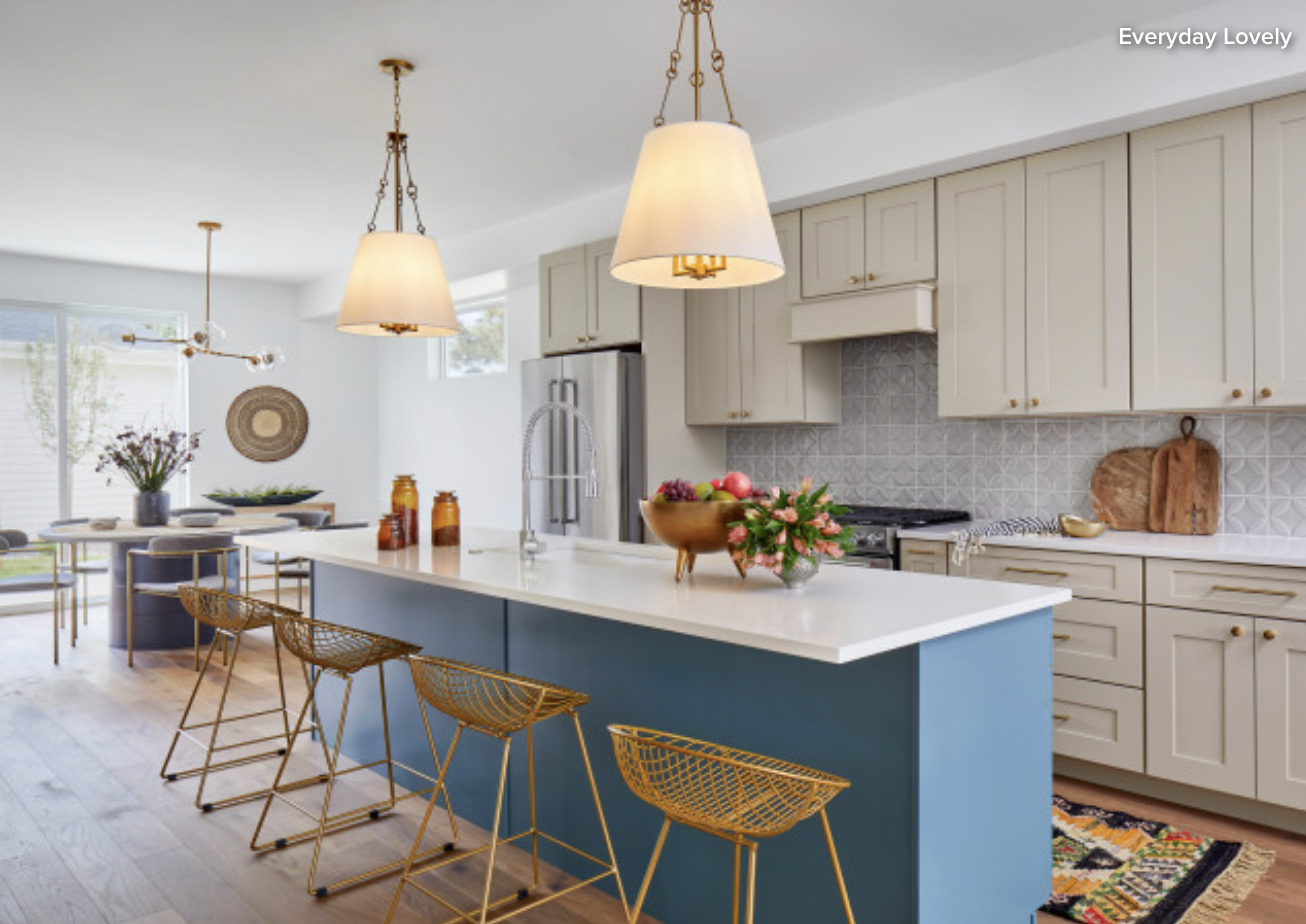
Check out these frequent dilemmas, experts’ tips on avoiding them and inspiring spaces that get things right
When it comes to kitchen planning, designers hear the same complaints from homeowners about what’s wrong or frustrating about their kitchens. Most of these recurring problems — and their resulting complaints — stem from a kitchen not having been designed with the owners’ needs in mind (often the case, of course, with inherited kitchens).
If you hire good designers, they’ll spend time asking you how you live in your home; how you use, or would like to use, your kitchen; and about your lifestyle, tastes and habits. You could get a head start by making a list of your kitchen likes and dislikes, frustrations and wishes, to help you avoid the issues outlined below.
All of the photos below show examples of good design and how to successfully handle common kitchen design problems.
Not Enough Storage
One of the most common kitchen design problems resulting from poor planning is insufficient storage. This can easily lead to clutter, mess and frustration. Yet even in really small kitchens, generous upper and lower cabinets should be achievable — you just need careful and sometimes imaginative planning to fully maximize the space.
Kitchen corner units, for example, can make use of otherwise unused space. In cases like this, pullout corner organizers keep contents accessible.
Similarly, drawers offer more generous storage for pans than cabinets do and are easier to access. Another option for a small kitchen is upper cabinets that extend to the ceiling, with a stool nearby for reaching the highest items.
There are also lots of clever storage options to consider, such as secret drawers or hidden spice racks, and many kitchen storage options are specifically designed for smaller items, such as gadgets, handheld appliances and utensils.
Carefully thinking about your storage needs from an early stage of the design process will ensure that you include enough of it and, in the long term, make for a much happier kitchen environment.
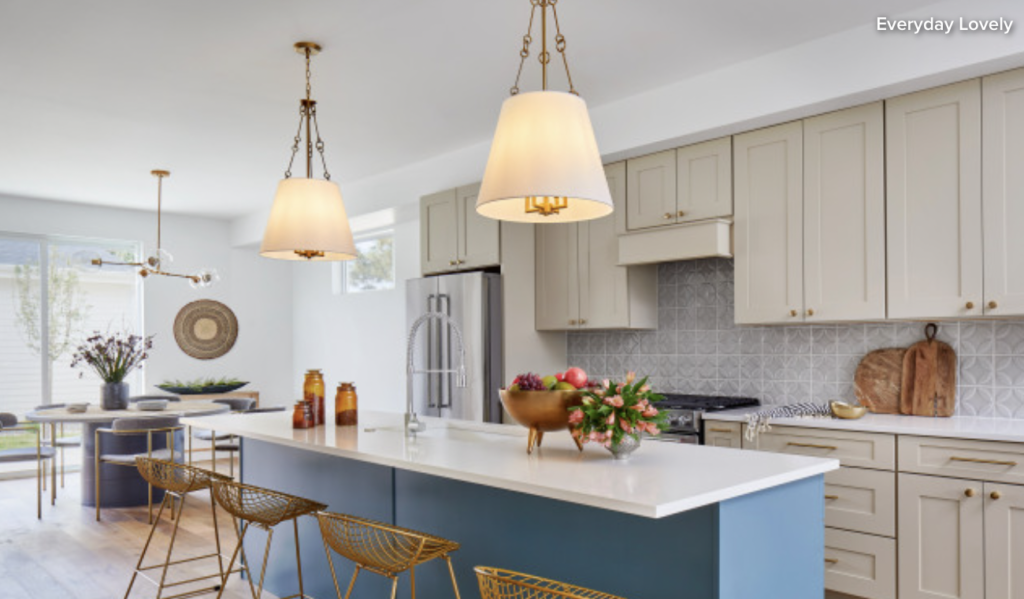
Badly Planned Layout and Workflow
A poor kitchen layout will make you work much harder than necessary and ultimately stop you from enjoying it. Your kitchen should work specifically for you, with a workflow and layout designed to cater to your individual needs.
For this to happen, your designer must enquire about your lifestyle, habits and kitchen requirements, as well as how many people live in your house, who likes to cook and what your preferred cooking style is. All this information should be used in the planning of your layout.
While a lot of designers still plan using the traditional kitchen triangle, I think defining separate areas or zones for prepping, washing and cooking can result in a more efficient and personalized design. This approach allows fluidity in the positioning of the different areas of the kitchen.
And, as in this example, your kitchen should look good too!
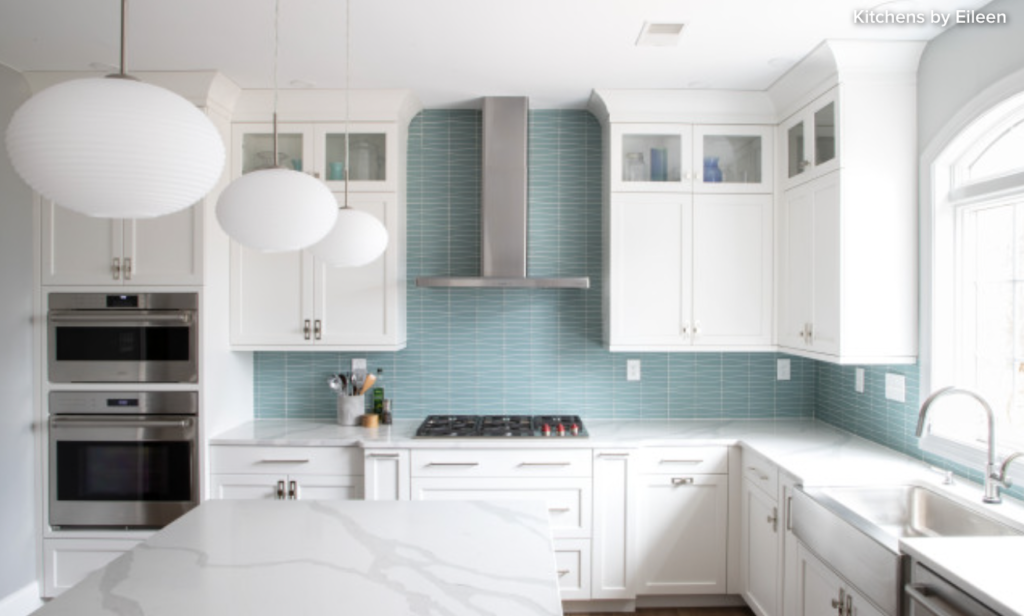
Insufficient Counter Space Where Needed
A lack of countertop space, or counters not being positioned where you need them, is a common design problem. It can also prove to be one of the most frustrating, since your counter is needed for just about every activity you’ll carry out in your kitchen.
The countertop forms part of the kitchen workflow, so this will help to determine where and how much of it you need. A common mistake is not leaving sufficient space next to or opposite a fridge or an oven. With a fridge, this counter space is merely convenient, but having space next to or opposite an oven and a cooktop, as seen in this scheme, is also important for safety. This way, you shouldn’t find yourself carrying piping-hot food across your kitchen, looking for a counter on which to set it down.
During planning, it’s important to think about all the ways in which you currently use, or intend to use, your countertops. For example, you may want space for more than one person to cook at once, or maybe an area where your partner can sit and chat to you while you cook, or it may be important to include somewhere for the kids to do their homework.
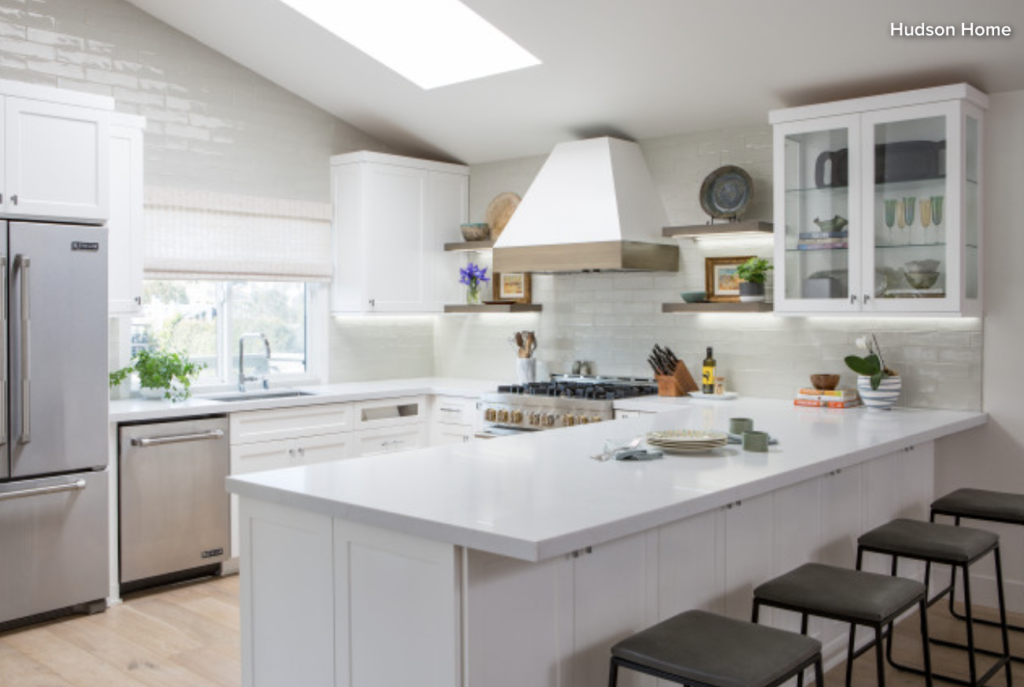
Traffic Through Your Working Area
As suggested, you may want enough countertop space for more than one person to operate in your kitchen at once. However, you need to consider how to achieve this so that users don’t get under one another’s feet while trying to reach the fridge, oven or sink.
Similarly, if you have children, you may want to ensure that they won’t come charging past as you’re carrying hot food or handling sharp knives. Both are examples of how traffic can become a problem in a kitchen’s work area, but they are preventable through careful planning.
This may mean setting up two separate and well-spaced prep zones or ensuring that there’s only one kitchen entry point, so you can easily see who’s coming or going, as shown. You can also make sure that frequently used appliances, such as the fridge, are on the periphery of your kitchen, so other household members can still get things out of them without having to fully enter the kitchen (also illustrated here).
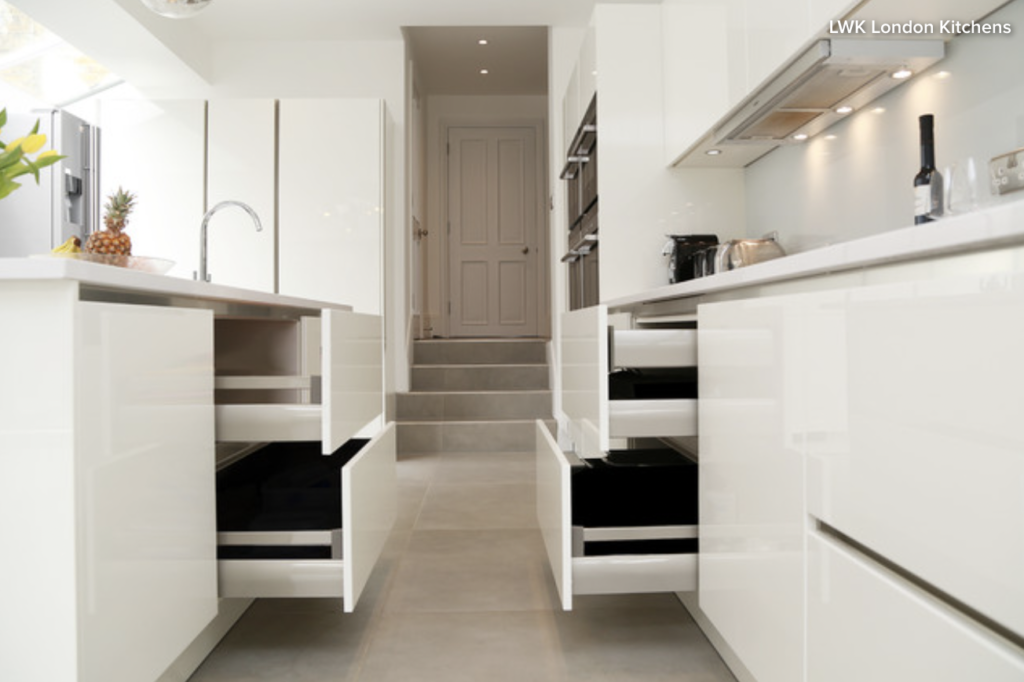
Badly Spaced Cabinets and Appliances
It’s important that cabinets and appliances, while well-positioned for easy use, are also well-spaced. For example, walkways should be about 36 inches wide so that doors and drawers can open clear of one another.
Similarly, they shouldn’t be too far apart: For the sake of a smooth workflow, you shouldn’t have to take more steps between appliances than is necessary. Similarly, it’s important not to place wall ovens and microwaves so high that you can’t safely remove hot food from them.
Think also about which way your cabinet and appliance doors open. For maximum ease of use, and where it’s possible, these should swing according to the surrounding kitchen space.
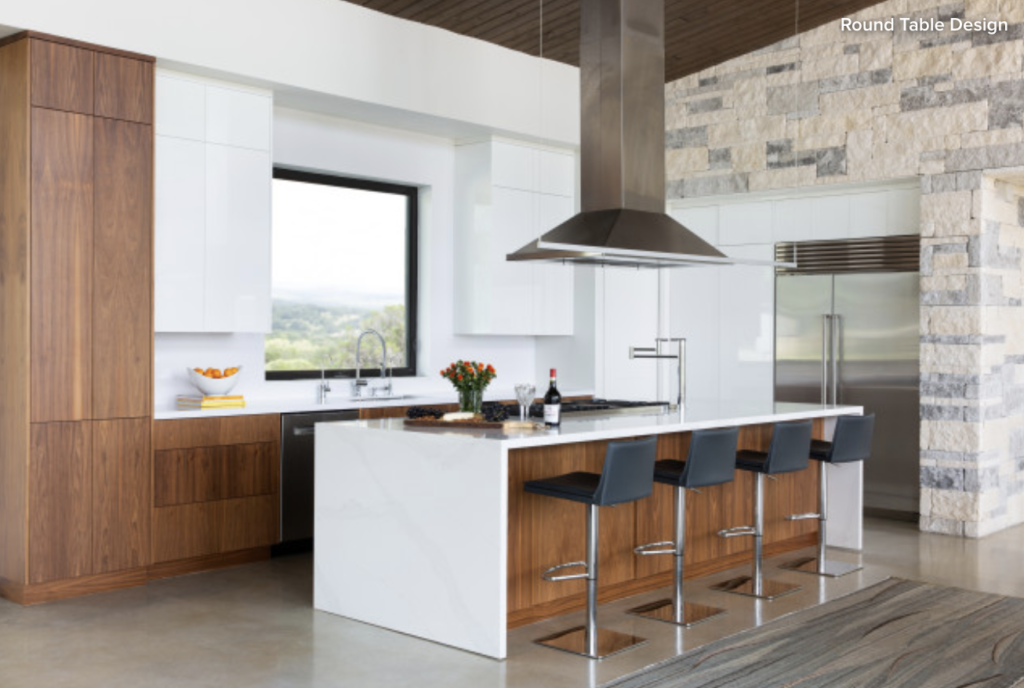
Poor Ventilation
Appropriate ventilation — such as with a range hood — allows the removal of grease, steam and cooking smells. These can otherwise linger on you, your clothes or any furniture, which is especially unpleasant in open-plan spaces.
Choose the best-quality model you can afford, and ensure that you pick the right sizeof ducting to fit your chosen hood. This should make for quieter, more effective extraction that’s also more energy-efficient and less likely to break. Consider, too, how much noise your potential range hood will make; another common mistake is not choosing a model with a quiet motor.
This is particularly relevant if your kitchen is part of an open-plan living space, or is big enough that everyone frequently gathers in it. They should comfortably be able to have a conversation or hear the TV while someone else is cooking.
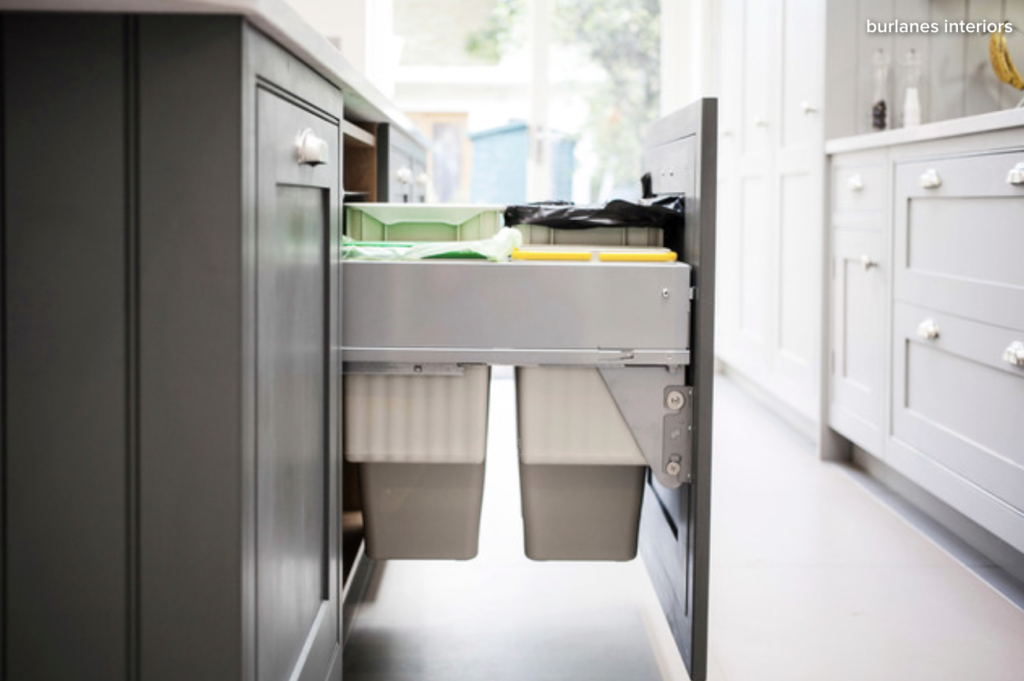
Inadequate Room for Trash and Recycling
Including sufficient trash space to suit a household’s needs is something that’s often overlooked.
Often a trash bin is present and fits neatly within a cabinet so that it maintains the kitchen’s clean aesthetic (and conceals smells). But the reality is that the container is too small and fills up too quickly, meaning constant emptying. Or another common problem is that there’s no provision for separating and storing recyclables.
As with many of the other design problems covered here, this one usually comes about because the designer hasn’t understood the homeowners’ requirements, dictated by how many people are in the house, how often they cook, their style of cooking, and whether recycling is important to them.
Providing a container with a larger capacity, one with separate compartments (as pictured) or a kitchen waste disposal unit are effective solutions to consider.
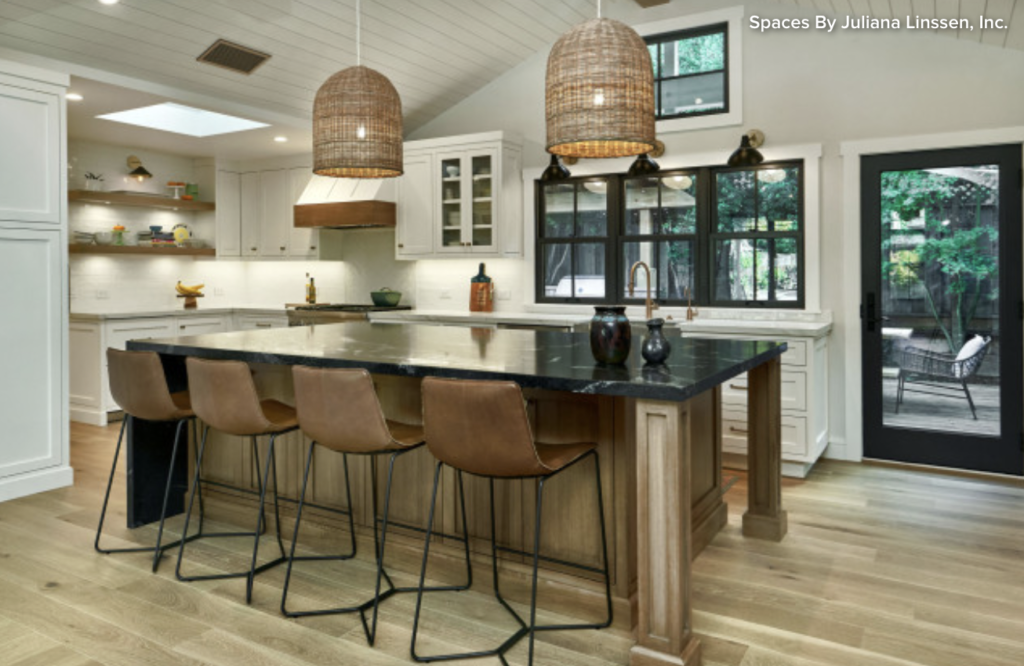
Insufficient Task Lighting
Another common complaint is not having enough task lighting. This kind of lighting is important, as it focuses direct light onto specific sites. These are mainly areas where you’re preparing and cooking food, such as the countertop, stove and sink areas.
Counters used for food preparation are often positioned directly under upper cabinets, so without additional lighting here, these cabinets can easily cast shadows and darken the surface, making cutting, slicing and other food preparation more challenging than it should be, or even potentially dangerous.
Again, this one is easily avoidable. Solutions include spotlights recessed into the underside of upper cabinets, or cabinet lighting to let you easily see the full contents of your cabinets. You may also make a focal point of your task lighting, such as installing statement pendants over an island, successfully combining practicality with high visual impact.
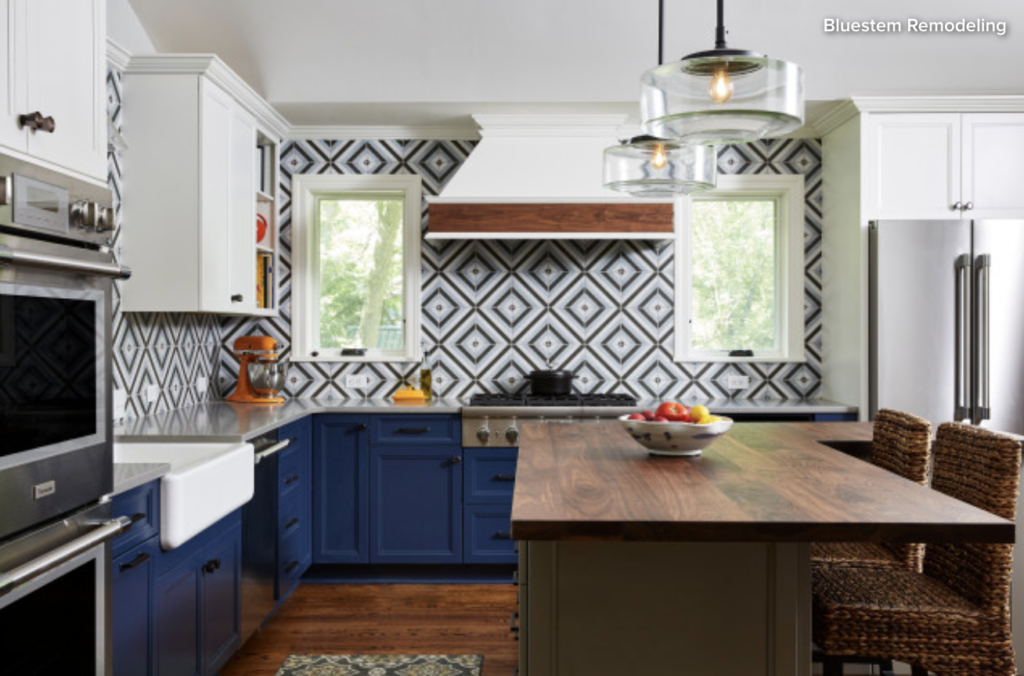
Poorly Planned Outlets and Switches
Often, you don’t realize that electrical switches and outlets aren’t where you need them until after a kitchen is finished.
We all use our kitchens differently, and your designer should take your needs into account when positioning these items. So don’t be afraid to convey your wishes. If you’d like additional outlets or a particular finish for the switch plate besides the standard white, this needs to be established during the planning stage.
Keep in mind, though, that the placement of electrical outlets is subject to safety regulations. Your designer should be able to advise you on these rules during the planning stage.
I’d love to hear your thoughts on today’s article! Comment in the section below.
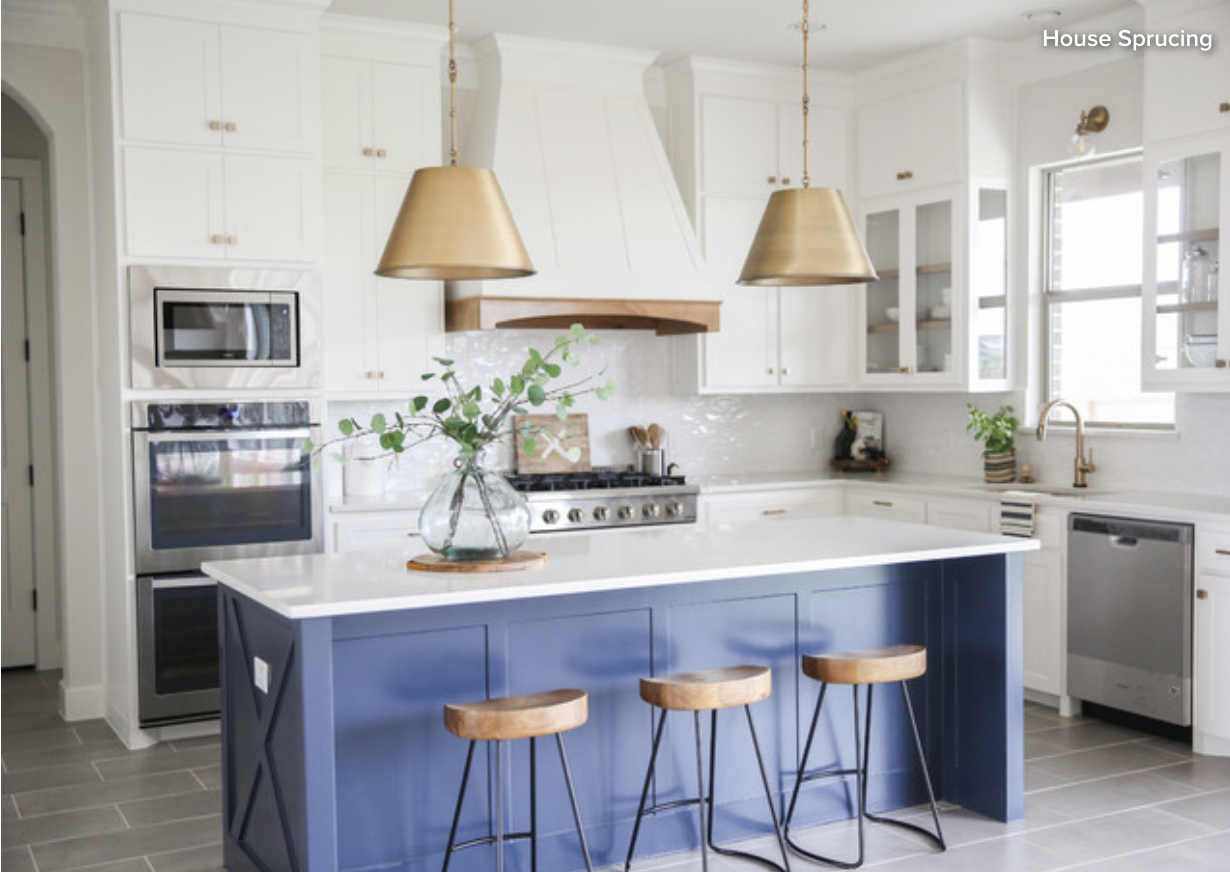
Is it faucets first and sinks second, or should cabinets lead the way? Here is a timeline for your kitchen remodel
Many homeowners think designing a kitchen starts with choosing items like appliances, flooring, cabinet finishes, countertops, faucets and lighting — and to a point it does. But I try to keep my clients from worrying about many of these items until after the space planning is complete. The huge number of options can be distracting, and it can be overwhelming to make all these decisions at once. Getting overcommitted too early can stifle creativity and hinder your progress in getting the best kitchen design for your home.
For some, choosing kitchen fixtures and finishes is like being a kid in a candy store. They like everything and can’t stay focused on what’s right for the overall aesthetic or design. For others, it’s paralyzing. They get so worried about picking the wrong finish or fixture that they have trouble making decisions or focusing on other important aspects of the job at hand.
Even though we always start a kitchen remodel with inspiration photos to get an overall idea of what the client wants the kitchen to look like, I often shelve most of those until after the preliminary plans are complete. I view kitchen remodels as a series of small, layered choices. Here are some ideas for how and when to make them after space planning is complete.
1. Appliances, Sinks and Lighting
I recommend that clients select appliances and sinks during the preliminary design phase, which often comes before selecting the rest of the finishes and fixtures. This is so the plans can reflect the proper sizes, which will in turn affect the cabinetry layout.
Also, I recommend choosing the type and amount of lighting fixtures during this phase: cans, semi-flush mounts, how many pendants over the island and so on, in order to complete the lighting plans so the contractor to provide estimates. Most people haven’t actually picked what style pendant light yet, but at least the decision about number is done.
It’s also time to decide whether or not you want a prep sink in addition to your main sink. At this point, by the way, it’s fine if you decide to change from a 36-inch range to a cooktop and wall oven.
By the time you get to final construction documents or order cabinets, however, these decisions must be finalized. The nice thing is that there are now a few big decisions that you can check off your list.
The decision on how many pendants to use affects how many junction boxes you need on the ceiling — and that decision needs to be made before plans get approved for permits and before the contractor closes up the drywall after rough electrical is done.
This is why the professional you hired may focus you on figuring out the lighting plan before picking out the countertops.
You might have selected your appliances earlier in the design phase, in terms of manufacturer, model number and size, but remember that stainless isn’t the only option. Some companies offer a vintage finish, while others offer a wide array of enameled colors. Choices like this can determine the look and feel of your kitchen in one sweeping gesture.
2. Cabinets, Countertops and Tile
Depending on what type of professional you hired, or if you are doing your own kitchen, you may start the finishes and fixture selection process from a different jumping-off point.
Rather than picking the cabinet wood species and finish color by itself, and then picking countertops and tile, I like to have my clients work on an overall palette of materials at the same time. Layer the materials and create collages of patterns, textures and colors to see what works best together.
Sure, a client might have the idea that they want a “white kitchen,” meaning white cabinets, but there are many “whites” out there, and what you mix them with really makes a huge impact on what the overall kitchen will look like.
For the modernists out there, you would think picking finishes and fixtures would be easier, with less adornment and fewer decisions to make. For some this might be true, but I find that for others this style can be just as challenging. It’s all about restraint and editing, and that’s hard.
The small choices in this kitchen include sleek appliances, noninvasive lighting, the full-height backsplash and the waterfall-style island countertop.
Tip: Order current samples of the materials you’re considering. Get a door sample with your style and finish for final approval. Make sure you go to the stone supplier and view and tag the actual slab of marble for your countertops, and make sure to order a current control sample of tile for your backsplash. All these extra steps will cut down on costly mistakes.
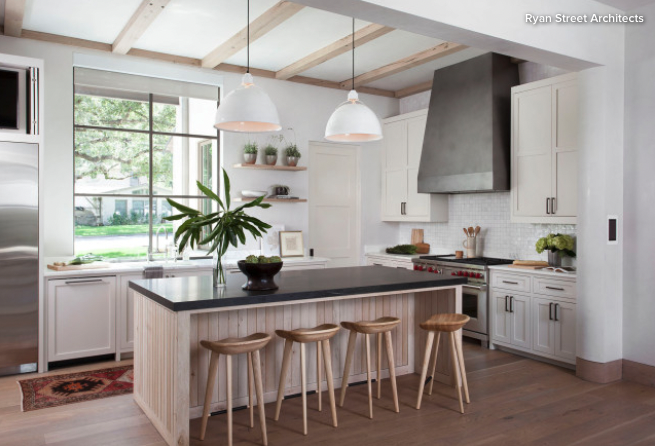
There are two actions that come to mind as being the most important in getting ready for a construction project: Avoid denial, and prepare. Everything you need to do falls under one of these two categories. But how, specifically, can you prepare for the first day of construction? Here are the basic steps.
1. Make a List of Items You Need to Have Onsite When Construction Begins
Have you ordered the sink and faucet? Do you have your appliance delivery scheduled? The reason for this is that once work starts, life gets a little more chaotic — OK, a lot more chaotic. Things like ordering a sink will slip through your fingers, and you’ll find yourself scrambling when the contractor asks for something.
2. Establish Expectations With Your Contractor
This isn’t just about telling the contractor what you expect, this is also about the contractor and other professionals letting you know what are realistic expectations. This will make for a happier client and a more pleasant process overall.
As the homeowner, you actually do have some control over the schedule. Taking too long to finalize decisions can cause significant delays.
Don’t forget to be nice to the neighbors and tell the contractor to do the same. Let the neighbors know you’re starting a construction project and that there will be crews around. Tell them to please let you know if they have issues. Noise, debris and blocking the street with deliveries are often issues that come up with neighbors.
Set up a recurring weekly construction meeting to touch base with your contractors and other pros. You may not need it every week, but at least it’s on the schedule in case you do.
Here are some things to consider and discuss with your contractor.
3. Empty Out Your Cabinets
So now that you’ve taken care of business, it’s time to get your hands dirty. Rather than dreading this, look at it as an opportunity to do some serious spring cleaning. Instead of throwing everything in a bunch of boxes and deferring the editing process to the end, get it done now to make moving back in that much more fun. However, if you’ve got too much on your plate to deal with this now, it can always be done later.
Put all the items you won’t need for a few months into boxes — or even better, big plastic bins with lids to protect the contents from dirt and dust. Separate out what you’ll want to use in your temporary kitchen: knives, coffee mugs, food you’ll eat and even a few wineglasses. Who says you have to drink out of plastic cups the whole time?
4. Set Up a Temporary Kitchen
The more organized and prepared you are in this area, the happier you’ll be. A half-hearted attempt at a temporary kitchen isn’t recommended. Even if you don’t have kids and plan to eat out every night, you’ll want a place to make a cup of coffee or a snack.
I think two tables are ideal, and if you have the room, two tables plus the kitchen table for seating. If you don’t have an old table, pick up a few folding tables — 24 or 30 inches deep by whatever length you can fit (not the 48-inch square ones, which are too deep to use as countertops). If you’re using a table from the house, get a plastic-coated tablecloth to protect it.
Think about setting up your temporary kitchen the way you would a real kitchen, in stations.
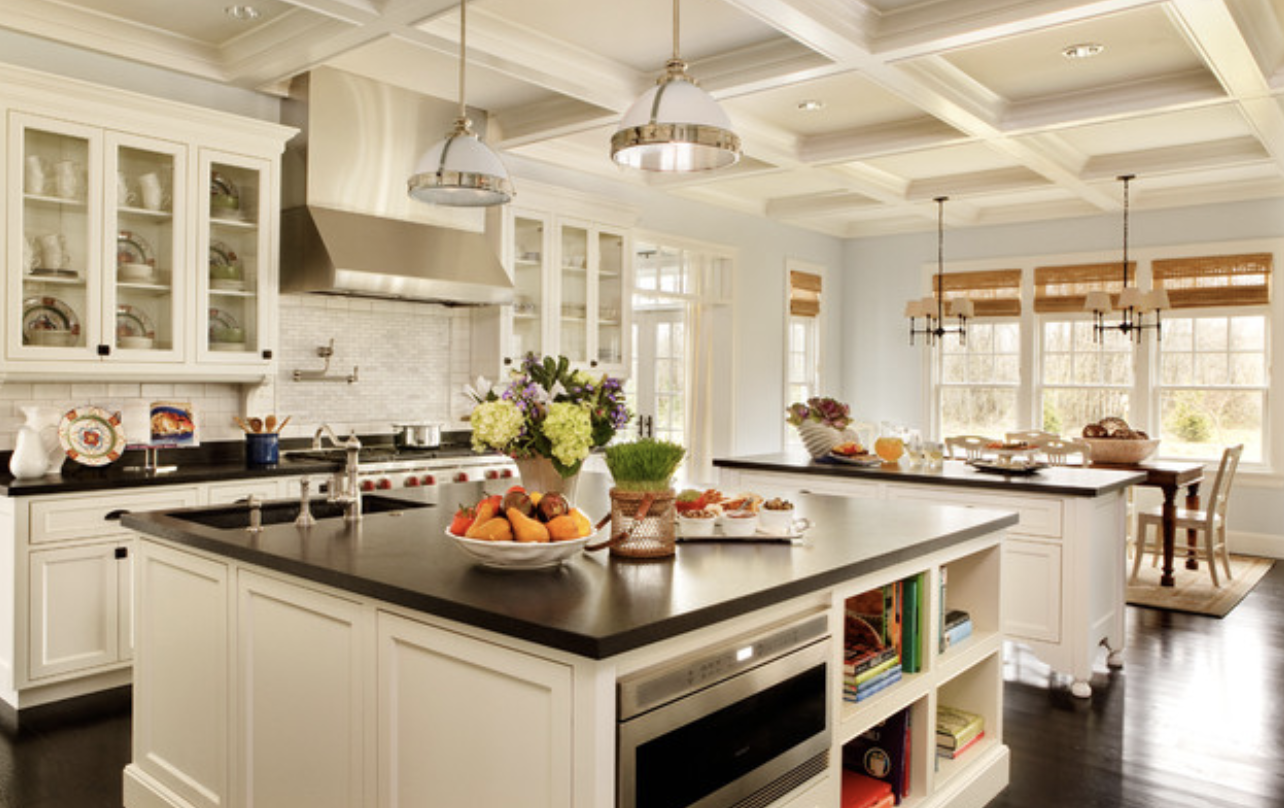
This natural stone has been around for thousands of years, and it comes in myriad color options to match any kitchen
Granite, the same stone that portions of ancient Egyptian pyramids are composed of, is ubiquitous in the kitchen for good reason. This stout stone that can weather millennia easily stands up to kitchen use and abuse. Is granite right for your kitchen? Have a look.
What to Know About Granite Countertops
The basics: Granite is a natural stone, composed of at least 20 percent quartz as well as mica and feldspar. Colors choices span the rainbow, from a monochromatic slab to bold patterns. Countertop finish options include:
Advantages: Granite is tough to beat when it comes to durability, due to its heat- and scratch-resistant qualities; it can bear up to 1,200 degrees Fahrenheit. Granite can also be stain and water resistant when it’s properly sealed. Those seeking an unusual slab or a unique pattern will not be disappointed with the seemingly limitless choices.
Disadvantages: Installation can get tricky due to granite’s hefty nature. And if you choose some of the more exotic slabs, costs can quickly escalate.
Sustainability: Granite’s durability means this product can outlast you and even your home. However, mining stone does disrupt local ecosystems and depletes finite, nonrenewable resources. Ecofriendly granite can be had with salvaged slabs. Also, you can choose granite that’s mined in your region to reduce transportation-related energy costs.
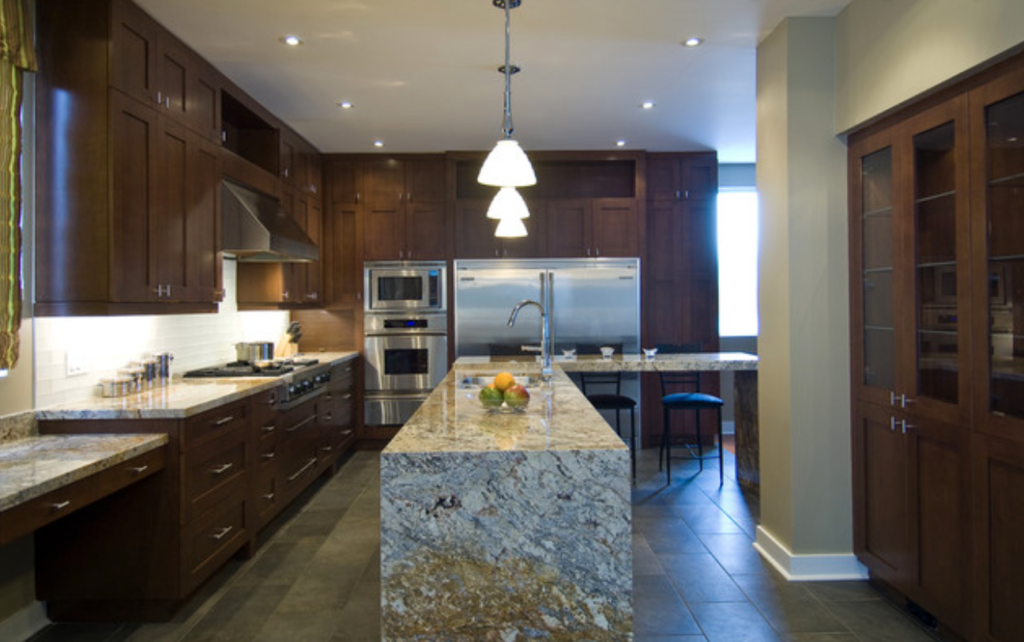
Maintenance: Limit routine care to a soft cloth and warm water or cleansers made specifically for granite. You’ll want to seal your slab every year or two with an impregnating water-based sealer made for granite.
Special considerations: You might have heard questions about radon content in granite.The U.S. Environmental Protection Agency has concluded that there is little or no health threat from granite counters, due to their relatively low radon content. You can read more here.
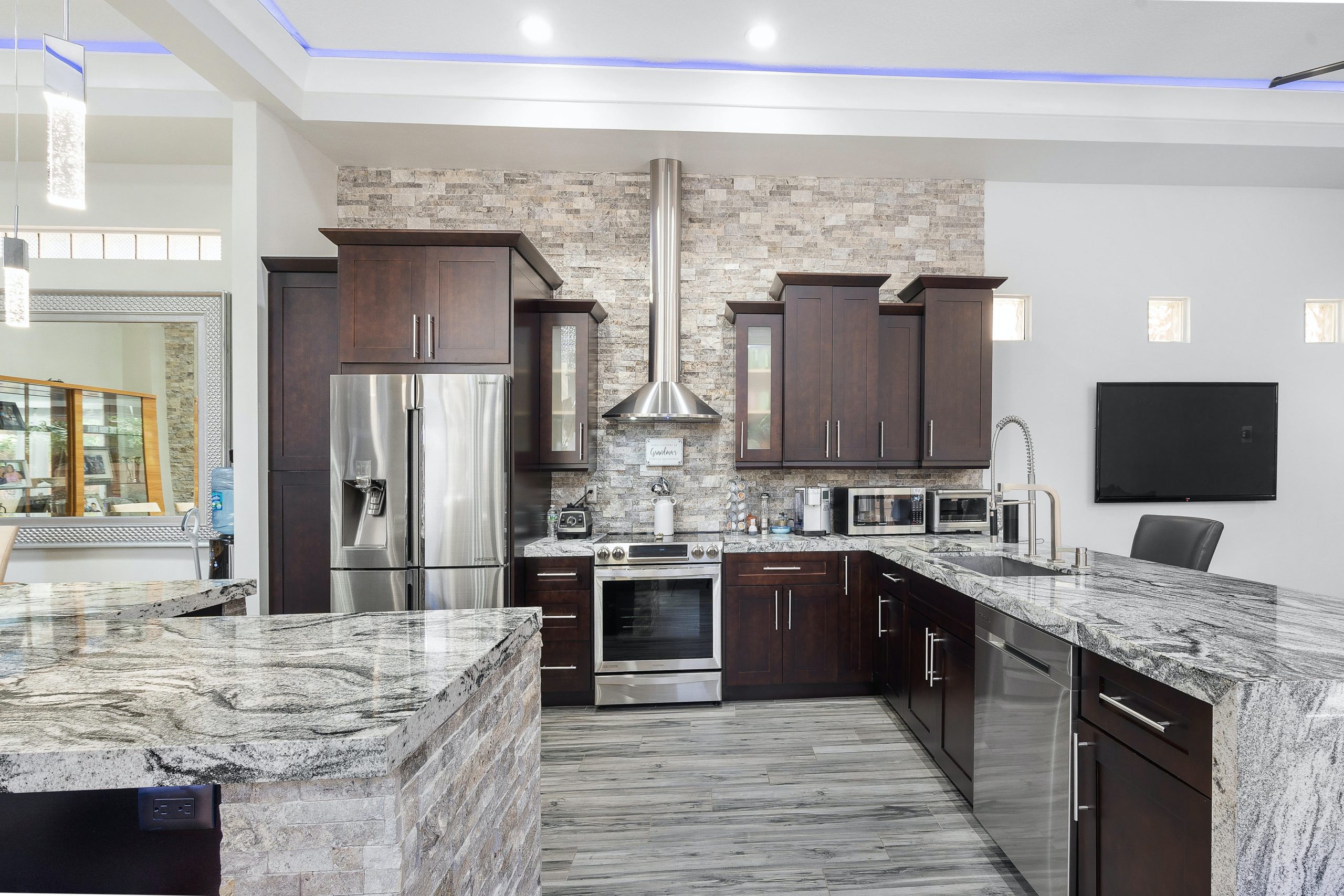
There’s a reason everyone “oohs” and “ahhs” over granite countertops—they have timeless style and durability to boot. No matter the reason for the upgrade (remodel, damage, new home), granite is a surface that can bring value and beauty to whatever space you choose. Keep reading to learn the seven key benefits of choosing granite countertops for your next kitchen remodel.
Unlike synthetic countertops, granite is created by nature. Each granite slab has unique fissures, swirls, and flecks of shiny iron bits. There may be 10 slabs at a showroom—all from the same quarry—with wildly varying characteristics. If you have a granite countertop in your kitchen, you know you have a piece that is truly one-of-a-kind.
Quality kitchen elements like granite counters make your space look more high-end and updated. Granite counters attract potential buyers, as they know they’re getting something they won’t have to update when they move in. The more turnkey a home is, the higher its value will be.
Different countertops have different prices, care requirements, and durability. Granite has a very high hardness rating. This means it can stand up to scratches and accidents better than other options (especially marble). For active families and busy kitchens, this is an exceptionally valuable feature.
When considering natural stone versus synthetic stone countertops, natural stones like granite are the more sustainable option. This is because they require minimal processing before they make it to your kitchen. Synthetic materials call for a lengthier and more complex production process, which may include toxic chemicals and releasing harmful emissions into the atmosphere.
Though granite countertops are highly resilient, accidents happen. Luckily, even if your granite counters get cracked or chipped, they are usually repairable. A countertop repair pro near you can often use filler materials to get your granite looking good-as-new again. If a heavy pot slips from your hands, or if a glass jar falls from your cabinet, it’s nice to have that extra peace of mind.
When choosing the right countertop, you can’t go by looks alone. You’ll also need to consider how well it’ll hold up against spaghetti sauce, red wine, or other spills. It’s also important that countertops don’t absorb all the icky germs and bacteria from raw meat during meal prep. Provided they get sealed properly at least once a year, your granite counters will wipe clean of all these messes.
Since granite gets formed naturally via pressure and heat, granite counters have built-in heat resistance. While it’s still a good idea to use potholders, you won’t have to worry about the scorching you’d get with other countertop varieties. Get in touch with a top-rated countertop installer near you to learn more.
If you’re shopping for natural stone countertops, you’ve probably considered granite and quartz varieties. While both of these stones are extremely durable, the biggest difference between quartz and granite is that granite stays true to its color the longest. Quartz can become discolored over time if left in direct sunlight. If you have a skylight in your kitchen, or just a lot of natural sun coming in, this is definitely something to think about
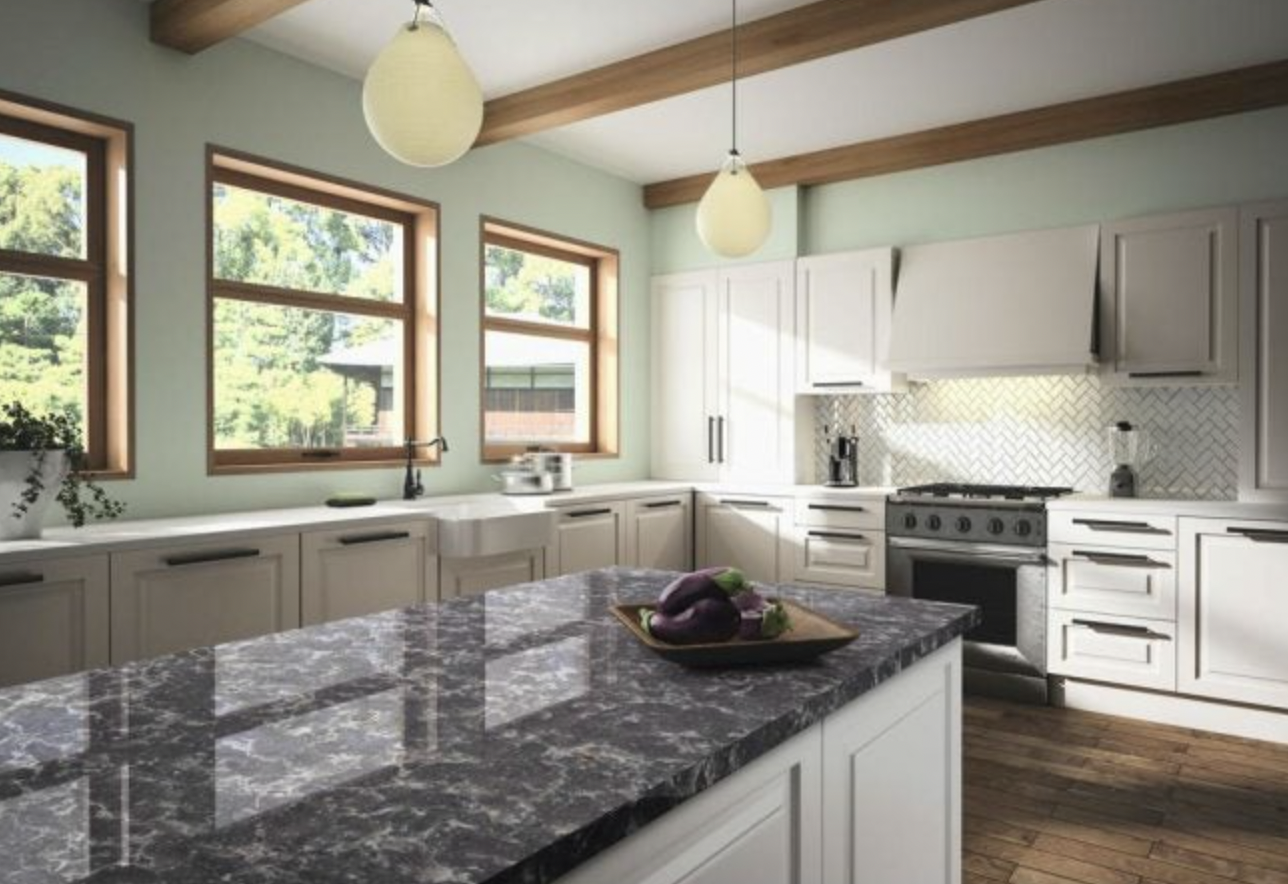
Beautiful, hygienic, and low-maintenance, engineered stone makes an ideal eco-friendly countertop surface.
Many new homeowners nowadays care about making eco-friendly choices. And when it comes to countertops, engineered stone is one of the most environmentally sensitive choices you can make. An alternative to natural stone cut from pure marble or granite, this factory-made composite features crushed stone (often quartz crystals in countertops and marble in wall and flooring products) bound in slab form with an adhesive or resin. In fact, because of the high percentage of quartz crystals found in countertops, the material is often simply called quartz.
Slabs used in the kitchen should be acid-resistant and non-absorptive, and a variety of products on the market made with crushed quartz crystals—including options from cambria, Silestone, Caesarstone —fit the bill. Most engineered stones are fantastic for high-wear uses such as kitchen countertops. The types and sizes of the components used to make the engineered stone that will determine its best uses. An engineered surface with large chunks of marble, for example, will be limited in performance to the pieces of marble it contains.
Unlike solid surfacing or plastic laminate, which are temperature-sensitive and can catch fire, engineered stone resists heat well. And unlike some other surfaces—even natural stones—engineered ones resist stains from liquids like wine or coffee.
Strong, durable, and attractive, engineered stone is very consistent in look and pattern. The non-porous surface is easy to maintain and heat-resistant, too. Some products can be specified as bacteria-resistant and not others, but since all are non-absorptive and resistant to heat, they should not be collecting bacteria in the first place.
Beyond brute strength and heat resistance, these man-made products come in a myriad of shades and styles. Some engineered stones are made to look like limestone or marble, enabling you to get the natural coloring and texture you want but with better performance. This also makes engineered stone counters a fine stand-in when you prefer to use recycled materials or protect natural resources like real marble. Plus, many contractors are familiar with the products and will install them properly.
It’s hard to create curves with engineered stone, but as far as typical countertop designs go, there’s nothing you can’t do with these products that you can accomplish with conventional stone. In fact, we’ve pushed the limits with edge and corner details and other shapes in engineered stone materials.
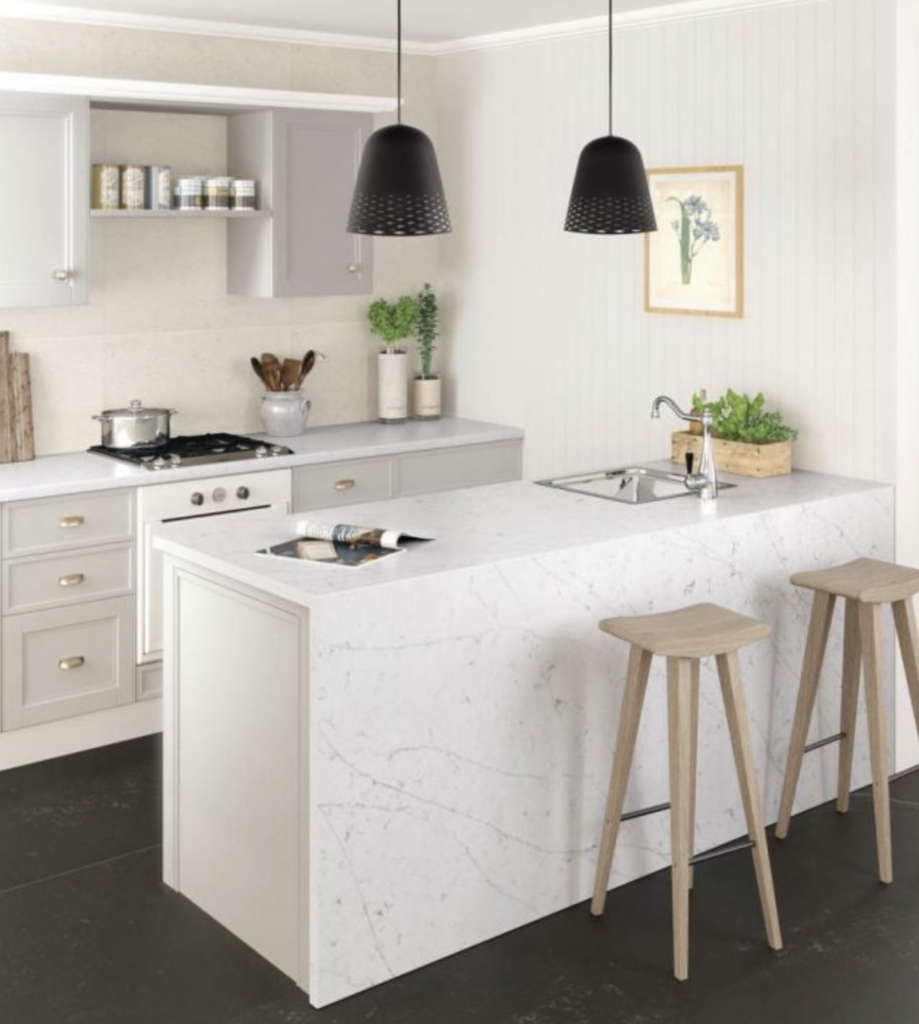
Generally about $60 to $100 per square foot installed.
With engineered stone, you pay for good performance and a long lifetime. Some colors and patterns are more expensive than others, but others can be quite affordable (I even put one of these in my own house).
Plus, while it’s expensive—definitely more so than plastic laminates—no more so than many natural stone slabs and solid surface materials. But consider this: For years we were specifying white marble with no veins, which looks great but is very expensive. Now to get that white look, we can use engineered stones, which look exactly the same as marble side by side but don’t cost as much. There are lots of suppliers, and the product delivers a consistent look.
Stay connected with all the latest trends in Kitchen & Bath! Sign up for our FREE Granite Buyers Club